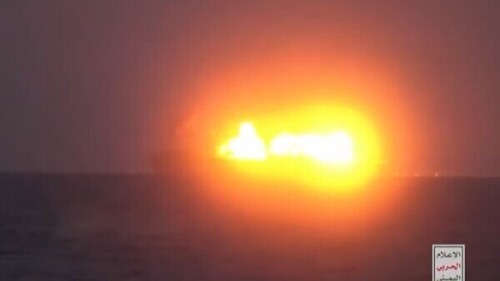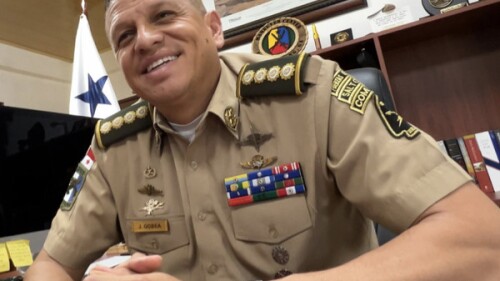Screenshot of a video reportedly depicting the March 11 rocket attack against Camp Taji in Iraq that left three coalition soldiers dead. (Aurora Intel) |
Two Americans were reportedly killed on Wednesday evening when more than a dozen katyusha-style rockets hit the Taji base in Iraq where US-led Coalition troops are based. It brings to four the number of Americans killed in a week. Two US Marines were killed fighting ISIS earlier this week. However the attack on Wednesday has all the finger prints of an Iranian-backed militia attack.
The US-led Coalition said that 15 small rockets had hit Camp Taji base at 7:35pm and that assessments were ongoing.
According to Jennifer Griffin at Fox News, two Americans and one British soldier were killed when 15 katyusha rockets struck the base at 7:52 in the evening. ISIS does not have the capability to fire so many rockets. The rocket attack is similar to an attack in December that killed a US contractor near K-1 base north of Kirkuk. That attack was carried out Kataib Hezbollah, a pro-Iranian militia in Iraq.
Kataib Hezbollah was responsible for a similar rocket attack that killed a US contractor in December. |
The US struck five Kataib Hezbollah targets in response. That cycle of airstrikes led to a protest at the US embassy and the US killing IRGC commander Qasem Soleimani and Kataib Hezbollah leader Abu Mahdi al-MUhandis on January 3.
US-Iran tensions have risen over the last year. In October and November there were around a dozen rocket attacks on bases with US troops and on the Green Zone. Since the January 3 airstrike Iran carried out a ballistic missile attack on Ayn al-Assad base in Iraq, wounding more than 100 Americans who suffered cuncussions.
The US had announced this week that it was seeking to deploy air defense against missile attacks to Iraq. It has been attempting to do so since January but bureaucratic hurdles have prevented the deployment. CENTCOM head General Kenneth McKenzie was in Iraq on February 4 to request deployment of the air defense systems and said on Tuesday that air defense was on the way to Iraq.
There are roughly 5,000 US personnel in Iraq at a half a dozen major installations.
There are some 5,000 US personnel in Iraq at a half a dozen major installations. Some 1,000 are at Ayn al-Assad with others at Camp Taji, Balad, Erbil, Baghdad and smaller posts such as Q-West. Patriot missiles will not necessarily help against the smaller rocket attacks, such as 107 mm rockets, that have been fired in the past. Mortars have also been used to harass bases such as Balad Air Force base.
Iran’s Press TV boasted about the attack on Camp Taji, noting it was also targeted on January 14. The Press TV report likely links Iran to the attack as Iran appears to have received information about the number of katyusha rockets fired. Iran says that as dozen rockets were fired. In recent weeks pro-Iranian groups have threatened the US in Iraq.
Nasral Shammari, spokesman for Harakat Hezbollah al-Nujaba has posted videos claiming that US soldiers are in the groups sights. Nujaba is an IRGC-linked organization and has been sanctioned by the US. The US has also sanctioned figures linked to Kataib Hezbollah, Asaib Ahl al-Haq and other pro-Iranian groups.
US Secretary of State Mike Pompeo has slammed Hadi al-Amiri, head of the Badr Organization, one of the most powerful pro-Iranian paramilitaries in Iraq. Amiri, Abu Mahdi and other members of the pro-Iranian Popular Mobilization Units of militias were all part of the storming of the US embassy compound in December. The PMU is the umbrella group that includes all the pro-Iranian militias that are alleged to have fired rockets in the past.
Muqtada al-Sadr (left) and Hadi al-Amiri |
The PMU is also part of the Iraqi Security Forces since 2018 when it was officially incorporated. A serious of airstrikes, which Iraq blamed on Israel, targeted PMU munitions warehouses in July and August 2019. In addition reports in 2018 and in December 2019 claimed that Iran has transferred ballistic missiles to PMU warehouses. Groups like Kataib Hezbollah play a key role in transferring Iranian munitions via Al-Qaim to Syria and onwards to Hezbollah.
After Abu Mahdi was killed in January the Iranian regime tasked Hezbollah in Lebanon with uniting the PMU in Iraq. Hezbollah sent Mohammed al-Kawtharani to Iraq in January to carry out Iran’s orders. Kartharani is from Najaf. He is close to Muqtada al-Sadr and also has worked with Amiri and others. A meeting in January in Qom with members of the PMU and Sadr also sought to cement an anti-American agenda.
Ali Shamkhani, the secretary of the Supreme National Security Council of Iran (Tasnim News Agency) |
It is known that Sadr returned from Qom in February due to the coronavirus outbreak. Iran sent the head of the Supreme National Security Council Ali Shamkhani this week to help coordinate Iraqi activities and the removal of US forces. He held high-level meetings with political leaders, including Amiri. He said the countdown to the removal of US forces had begun, echoing sentiments expressed by Nujaba head Akram al-Kaabi in February. Shamkhani’s visit may be seen as a curtain raiser for the recent attack on US troops on March 11.
A US response to the killing is expected. The US has responded in the past after the December casualty. Iran government media’s boast that “a dozen US-led Coalition” members were injured appears to implicate Iranian groups. Stars and Stripes and other media have reported the casualty figures of two Americans and one British personnel.
Seth Frantzman, a Middle East Forum writing fellow, is the author of After ISIS: America, Iran and the Struggle for the Middle East (2019), op-ed editor of The Jerusalem Post, and founder of the Middle East Center for Reporting & Analysis.










